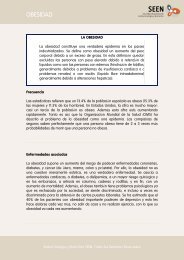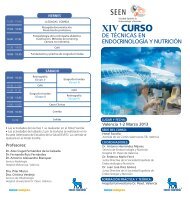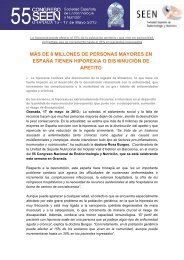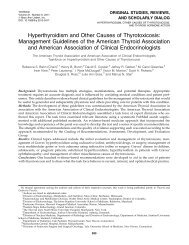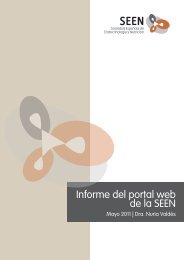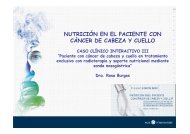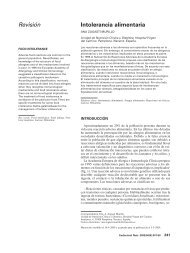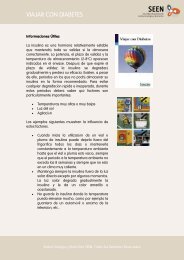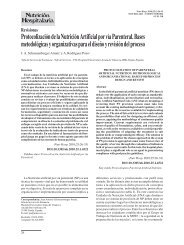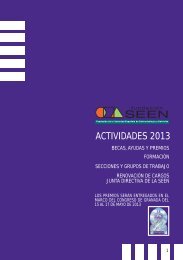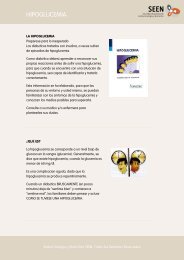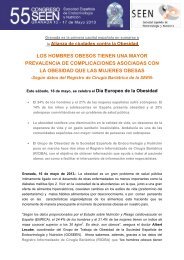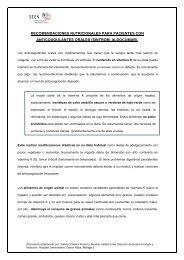Guías clínicas. Análisis crítico - Sociedad Española de ...
Guías clínicas. Análisis crítico - Sociedad Española de ...
Guías clínicas. Análisis crítico - Sociedad Española de ...
You also want an ePaper? Increase the reach of your titles
YUMPU automatically turns print PDFs into web optimized ePapers that Google loves.
<strong>Guías</strong> <strong>clínicas</strong>. <strong>Análisis</strong> <strong>crítico</strong><br />
Dra. Mª Ángeles Valero Zanuy<br />
Hospital Univ. 12 <strong>de</strong> Octubre. Madrid
Definición <strong>de</strong> MBE<br />
• Es la utilización consciente, explícita y juiciosa <strong>de</strong> la mejor evi<strong>de</strong>ncia científica<br />
disponible a la hora <strong>de</strong> tomar <strong>de</strong>cisiones sobre el cuidado <strong>de</strong> los pacientes<br />
• Nace por:<br />
– Variabilidad:<br />
• <strong>de</strong>pendiente <strong>de</strong>l clínico en las observaciones, percepciones,<br />
razonamientos, intervenciones y estilo <strong>de</strong> práctica clínica<br />
• <strong>de</strong>pendiente <strong>de</strong>l entorno y condiciones <strong>de</strong> trabajo<br />
• <strong>de</strong>pendiente <strong>de</strong>l paciente: características <strong>clínicas</strong> <strong>de</strong> cada paciente y<br />
estado <strong>de</strong> salud <strong>de</strong> la población<br />
– Cantidad <strong>de</strong> información científica disponible:<br />
• Cantidad<br />
• Inaccesibilidad o falta <strong>de</strong> <strong>de</strong>streza en el análisis <strong>de</strong> la información<br />
• Presencia <strong>de</strong> información incorrecta o ten<strong>de</strong>nciosa<br />
– Prácticas no contrastadas:<br />
• Modas<br />
• Acciones no contrastadas<br />
– Coste-efectividad en la atención sanitaria
Organización <strong>de</strong> la evi<strong>de</strong>ncia: pirámi<strong>de</strong> <strong>de</strong> Haynes<br />
Sistemas<br />
Sinápsis<br />
Síntesis<br />
Estudios<br />
• Sistemas:<br />
– UP to Date: www.UpToDate.com<br />
– Sientific American Medicine:<br />
www.Samed.com<br />
– Harrison on line:<br />
www.Harrisons.accessmedicine.com<br />
– Manual MerK:<br />
www.merk.com/pubs/mmanual<br />
– Clinical evi<strong>de</strong>nce:<br />
www.clinicalevi<strong>de</strong>nce.com<br />
• Sinápsis<br />
– ACP journal club: www.acpjc.org<br />
• Síntesis<br />
– Cochrane Library:<br />
www.uptodate.software.com<br />
– National Institute for Clinical<br />
Excellence: www.nice.org.uk<br />
• Estudios<br />
– PubMed:<br />
www.ncbl.nlm.nih.gov/PubMed
Concepto <strong>de</strong> guía clínica<br />
• Son documentos que se han <strong>de</strong>sarrollado <strong>de</strong><br />
forma sistemática para disminuir la variabilidad<br />
<strong>de</strong>l cuidado médico y que sirve para ayudar a<br />
los clínicos y a los pacientes en la toma <strong>de</strong><br />
<strong>de</strong>cisiones en aspectos <strong>de</strong> salud<br />
Committe to Advise the Public Health Service on Clinical Practice Gui<strong>de</strong>lines. Institute of<br />
Medicine. Clinical Practice Gui<strong>de</strong>lines: Directiones of a New Program. Field MJ and Lohr KN,<br />
ed. Washington DC: National Aca<strong>de</strong>my Press:1990
Método para <strong>de</strong>sarrollar una guía<br />
• Opinión <strong>de</strong> expertos<br />
Proceso Implícito<br />
• Métodos <strong>de</strong> consenso<br />
• Métodos basados en la<br />
evi<strong>de</strong>ncia<br />
Proceso Explícito
Presentación <strong>de</strong> una guía<br />
• Introducción y justificación<br />
• Informe <strong>de</strong>l método <strong>de</strong> búsqueda y método <strong>de</strong> la revisión<br />
sistemática<br />
• Discusión <strong>de</strong> los estudios<br />
• Recomendaciones finales<br />
• Resumen <strong>de</strong> la guía<br />
• Lista <strong>de</strong> nombres <strong>de</strong> participantes
Objetivos <strong>de</strong> las guías<br />
• Evitar la variabilidad en la práctica<br />
clínica<br />
• Evitar el uso ina<strong>de</strong>cuado <strong>de</strong><br />
intervenciones <strong>clínicas</strong> (mal uso por<br />
exceso o por <strong>de</strong>fecto)<br />
• Evitar el uso ina<strong>de</strong>cuado <strong>de</strong><br />
intervenciones <strong>clínicas</strong> en ausencia<br />
<strong>de</strong> evi<strong>de</strong>ncia científica<br />
• Ser herramientas educacionales<br />
• Sirvir para establecer protocolos <strong>de</strong><br />
actuación institucionales<br />
• Servir para valorar<br />
financiación/rembolso<br />
Intervenciones <strong>de</strong><br />
mejor calidad (MBE)<br />
Disminución <strong>de</strong>l<br />
coste sanitario
Características <strong>de</strong> las guías<br />
• Brevedad<br />
• Vali<strong>de</strong>z<br />
• Fiabilidad<br />
• Reproductibilidad<br />
• Flexibilidad<br />
• Claridad<br />
• Elaboración multidisciplinar<br />
• Metodología y documentación<br />
Mc Clave SA. Crit Care Clin 2010;26:451-66.
Dirigidas a<br />
Personal<br />
sanitario<br />
Compañías<br />
aseguradoras<br />
<strong>Guías</strong><br />
Clínicas<br />
Enfermos<br />
Familiares<br />
Cuidadores<br />
Industria<br />
Expertos en<br />
Medicina Legal
Agency for Health Care Policy and Research Clinical Practice Gui<strong>de</strong>lines. No. 1. AHCPR<br />
Publication No. 1. AHCPR Publication No. 92-0023; 1993.<br />
Calidad y fortaleza <strong>de</strong> las guías<br />
Scottish Intercollegiate Gui<strong>de</strong>lines Network, SIGN Gui<strong>de</strong>lines –on introduction to SIGN<br />
methodology for the <strong>de</strong>velopment of evi<strong>de</strong>nce basa<strong>de</strong>d clinical gui<strong>de</strong>lines. Edinburgh: SIGN<br />
Publication No. 39, SIGN Secretariat. Royal College of Physitians of Edinburgh; 1999.
Calidad y fortaleza <strong>de</strong> las guías<br />
Grado <strong>de</strong> recomendación:<br />
A: apoyado por al menos 2 estudios <strong>de</strong> nivel I;<br />
B: apoyado por al menos 1 estudio <strong>de</strong> nivel I;<br />
C: apoyado por al menos 1 estudio nivel II;<br />
D: apoyado por al menos 1 estudio nivel III;<br />
E: apoyado por estudios <strong>de</strong> nivel IV o V.<br />
Nivel <strong>de</strong> evi<strong>de</strong>ncia:<br />
I: gran<strong>de</strong>s estudios randomizados con bajo riesgo <strong>de</strong> falsos positivos<br />
y/o negativos;<br />
II: pequeños estudios randomizados, con resultados inciertos y<br />
mo<strong>de</strong>rado-alto riesgo <strong>de</strong> falsos positivos y/o negativos;<br />
III: cohortes no randomizadas con controles contemporáneos;<br />
IV: cohortes no randomizados con controles históricos;<br />
V :series <strong>de</strong> casos, estudios no controlados y opiniones <strong>de</strong> expertos.<br />
Dellinger BP et al. Crit Care Med 2004;32:858-73.
Diferentes guías en Medicina<br />
• EEUU:<br />
– US. Preventive Services Task Force<br />
– Advisory Committe on Inmunization Practice<br />
– National Aca<strong>de</strong>my<br />
– Centers for Disease Control and Prevention<br />
• Otras:<br />
– World Health Organization<br />
– National Institute for Clinical Excellence (NICE)<br />
– Diferentes <strong>Sociedad</strong>es Científicas
Diferentes guías en Nutrición<br />
• Italian Society for Parenteral and Enteral Nutrition<br />
• German Society for Nutritional Medicine<br />
• Scottish Home Parenteral Nutrition Managed Clinical Network<br />
• Gui<strong>de</strong>lines from the UK National Institute for Health & Clinical<br />
Excellence (NICE) on Nutrition Support in Adults<br />
• European Society of Parenteral and Enteral Nutrition (ESPEN)<br />
• American Society for Parenteral and Enteral Nutrition (ASPEN)<br />
• Joint recommendations of the American Society for Parenteral and<br />
Enteral Nutrition and the American Society for Clinical Nutrition<br />
• Australian Society of Parenteral and Enteral
Elaboración <strong>de</strong> guías ESPEN<br />
GUIDELINES LEADING COMMITTE (GLC):<br />
2 miembros <strong>de</strong>signados por Executive Committe<br />
ESPEN chair<br />
ESPEN Educational and Clinical Practice Committe chair<br />
Metodólogo<br />
GUIDELINES DEVELOPMENT COMMITTE (GDC):<br />
8 – 16 miembros<br />
PRESENTACION GUIAS EN CONGRESO ESPEN<br />
PUBLICACION DE GUIA EN CLINICAL NUTRITION<br />
TAREAS <strong>de</strong> GLC:<br />
Definir temas/tópicos<br />
Nombrar el DGC chair<br />
Aprobar los GDC miembros<br />
Definir la agenda<br />
Monitorizar progresos<br />
Realizar auditorias<br />
Revisar y aprobar el documento<br />
final<br />
Declarar conflictos <strong>de</strong> intereses<br />
TAREAS <strong>de</strong> GDC:<br />
Listar términos MeSH<br />
Definir cuestiones a analizar<br />
Seleccionar artículos relevantes<br />
Graduar los artículos según<br />
calidad<br />
Proponer revisores externos<br />
Escribir documento final<br />
Declarar conflictos <strong>de</strong> intereses
Proceso <strong>de</strong> elaboración <strong>de</strong> las guías ESPEN<br />
10<br />
9<br />
8<br />
7<br />
6<br />
5<br />
4<br />
3<br />
2<br />
1<br />
Pasos<br />
• Paso 1: Aprobación por<br />
<strong>Sociedad</strong> Científica<br />
• Paso 2: Selección <strong>de</strong> áreas<br />
temáticas y tópicos<br />
• Paso 3: Selección <strong>de</strong> miembros<br />
<strong>de</strong>l Gui<strong>de</strong>line Development<br />
Committe<br />
• Paso 4: Educación sobre<br />
aspectos metodológicos <strong>de</strong> los<br />
miembros<br />
• Paso 5: Revisión <strong>de</strong> la literatura
Proceso <strong>de</strong> elaboración <strong>de</strong> las guías ESPEN<br />
10<br />
9<br />
8<br />
7<br />
6<br />
5<br />
4<br />
3<br />
2<br />
1<br />
• Paso 6: Asistencia formal a<br />
cuestiones específicas<br />
• Paso 7: Formulación <strong>de</strong><br />
recomendaciones<br />
• Paso 8: Revisión externa (peerreview)<br />
• Paso 9: Escritura <strong>de</strong>l<br />
documento final<br />
• Paso 10: Presentación y<br />
diseminación <strong>de</strong> la guía<br />
Pasos
ESPEN EN Gui<strong>de</strong>lines<br />
1. Introduction<br />
2. Methodology<br />
3. Definitions and General topics<br />
4. The patient's journey<br />
5. Ethical and legal aspects<br />
6. Cardiology and Pulmonology<br />
7. Gastroenterology<br />
8. Geriatrics<br />
9. Hepatology<br />
10. Wasting in HIV<br />
11. Intensive care<br />
12. Non-surgical oncology<br />
13. Pancreas<br />
14. Renal failure<br />
15. Surgery and transplantation<br />
Clin Nutr 2006;25:177-360
ESPEN PN Gui<strong>de</strong>lines<br />
1. Adult Renal Failure<br />
2. Cardiology and Pneumology<br />
3. Central Venous Catheters<br />
4. Gastroenterology<br />
5. Geriatrics<br />
6. Hepatology<br />
7. Home Parenteral Nutrition in adults<br />
8. Intensive Care<br />
9. Non-surgical oncology<br />
10. Pancreas<br />
11. Present status and perspectives<br />
12. Surgery and Transplantation<br />
Clin Nutr 2009; 28:359-479
ASPEN PN and EN Gui<strong>de</strong>lines<br />
1. Standar of Practice: Nutrition Support Pharmacist. Nutr Clin Pract 1999;14:275-81<br />
2. Standar of Practice: Nutrition Support Dietitian. Nutr Clin Pract 2000;15:53-9<br />
3. Standar of Practice: Nutrition Support Nurse. Nutr Clin Pract 2001;16:56-62<br />
4. Standar of Practice: Nutrition Support Hospitalized Adult Patients. Nutr Clin Pract 2002;17:384-91<br />
5. Standar of Practice: Nutrition Support Physician. Nutr Clin Pract 2003;18:270-562<br />
6. Safe Practices for Parenteral Nutrition. JPEN 2004;28:S39-70<br />
7. Standar of Practice: Nutrition Support Hospitalized Pediatric Patients. Nutr Clin Pract<br />
2005;20:103-16<br />
8. Standar for Specialized Nutrition Support: Home Care Patients. Nutr Clin Pract 2005;20:579-90<br />
9. Definition of term, style and conventions used in ASPEN gu<strong>de</strong>lines and standards. Nutr Clin Pract<br />
2005;20:579-90<br />
10. Standar for Specialized Nutrition Support for Adult Resi<strong>de</strong>nt of Long-term care facilities. Nutr Clin<br />
Pract 2006;21:96-104<br />
11. Gui<strong>de</strong>lines for the use of Parenteral and Enteral Nutrition in Adults and Pediatric Patients. JPEN<br />
2002;26S:1SA-138SA<br />
NCP 2006;21:529-32
ASPEN PN Gui<strong>de</strong>lines<br />
• Cardiology and Pneumology<br />
• Central Venous Catheters<br />
• Gastroenterology<br />
• Geriatrics<br />
• Hepatology<br />
• Home Parenteral Nutrition in adults<br />
• Intensive Care<br />
• Oncology<br />
• Nephrology<br />
• Pacreas Disease<br />
• Surgery and Transplantation<br />
NCP 2006;21:529-32
Calidad y fortaleza <strong>de</strong> las guías en Nutrición<br />
• Screening for nutrition risk is suggested for hospitalized<br />
patients: Gra<strong>de</strong> E<br />
• Nutrition assesment is suggested for all patients who are<br />
i<strong>de</strong>ntified to be at nutrition risk by nutrition screening:<br />
Gra<strong>de</strong> E<br />
• Nutrition support intervention is recommen<strong>de</strong>d for patients<br />
i<strong>de</strong>ntified by screening and assessment as at risk for<br />
malnutrition or malnourished:Gra<strong>de</strong> C<br />
Mueller Ch et al. JPEN 2011;35:16-24
Calidad y fortaleza <strong>de</strong> las guías en Nutrición<br />
%<br />
100<br />
90<br />
80<br />
56.0<br />
70<br />
60<br />
50<br />
28.2<br />
40<br />
30 15.8<br />
20<br />
10<br />
0<br />
Grado A Grado B GradoC<br />
• No ético establecer grupo placebo<br />
• Dificultad <strong>de</strong> realizar un estudio<br />
ciego<br />
• Imposibilidad <strong>de</strong> valoración con<br />
variables tipo LOS, morbilidad y<br />
mortalidad en algunos aspectos<br />
nutricionales<br />
• Consi<strong>de</strong>ración <strong>de</strong> nutrición artificial<br />
como un tratamiento “sustitutivo” a<br />
una función vital<br />
• Consi<strong>de</strong>ración <strong>de</strong> aspectos éticos
Bozzeti F and Forbes A. Clin Nutr 2009;28:359-64
• Encuesta enviada a 5220<br />
miembros ASPEN vía e-mail, Mayo<br />
2005<br />
• 470 respon<strong>de</strong>dores (9 %)<br />
• 1/3 miembros <strong>de</strong> ASPEN hace<br />
menos <strong>de</strong> 2 años<br />
• 99 % conocían guías ASPEN<br />
Seres D et al. NCP 2006;21:529-32
Frecuencia <strong>de</strong>l uso <strong>de</strong> las guías<br />
%<br />
100<br />
90<br />
80<br />
70<br />
60<br />
50<br />
40<br />
30<br />
20<br />
10<br />
0<br />
14 % 13 %<br />
45 %<br />
29 %<br />
Daily Weekly Monthly Rarely or<br />
never<br />
Seres D et al. NCP 2006;21:529-32
Utilidad <strong>de</strong> las guías<br />
%<br />
100<br />
90<br />
80<br />
70<br />
60<br />
50<br />
40<br />
30<br />
20<br />
10<br />
0<br />
Support for clinical recommendations<br />
73 %<br />
Seres D et al. NCP 2006;21:529-32<br />
59 %<br />
Patients care<br />
43 %<br />
Quality improvement efforts<br />
32 %<br />
5 %<br />
For studying<br />
Teaching stu<strong>de</strong>nts
Efectos <strong>de</strong> las guías sobre el cuidado <strong>de</strong> los pacientes<br />
%<br />
100<br />
90<br />
80<br />
70<br />
60<br />
50<br />
40<br />
30<br />
20<br />
10<br />
0<br />
40 %<br />
Mejoran el cuidado<br />
Seres D et al. NCP 2006;21:529-32<br />
5.4 %<br />
No mejoran el<br />
cuidado<br />
44.4 %<br />
No influyen
Nivel <strong>de</strong> complejidad <strong>de</strong> las guías<br />
%<br />
100<br />
90<br />
80<br />
70<br />
60<br />
50<br />
40<br />
30<br />
20<br />
10<br />
0<br />
80 %<br />
16 %<br />
4 %<br />
Normal Muy básicas Muy complejas<br />
Seres D et al. NCP 2006;21:529-32
Aspectos más importantes <strong>de</strong> las guías<br />
%<br />
100<br />
90<br />
80<br />
70<br />
60<br />
50<br />
40<br />
30<br />
20<br />
10<br />
0<br />
Nivel <strong>de</strong> evi<strong>de</strong>ncia<br />
Seres D et al. NCP 2006;21:529-32<br />
61 % 57 %<br />
Revisión <strong>de</strong> la evi<strong>de</strong>ncia<br />
Grado <strong>de</strong> recomendación<br />
45 %<br />
Consi<strong>de</strong>raciones especiales<br />
36 %
Utilizan las citas bibliográficas <strong>de</strong> las guías<br />
%<br />
100<br />
90<br />
80<br />
70<br />
60<br />
50<br />
40<br />
30<br />
20<br />
10<br />
0<br />
Si<br />
65 %<br />
No<br />
35 %<br />
Seres D et al. NCP 2006;21:529-32
Organización <strong>de</strong> las guías<br />
%<br />
100<br />
90<br />
80<br />
70<br />
60<br />
50<br />
40<br />
30<br />
20<br />
10<br />
0<br />
84 %<br />
Bien<br />
Mal<br />
16 %<br />
Seres D et al. NCP 2006;21:529-32
Forma <strong>de</strong> presentación <strong>de</strong> las guías<br />
100 %<br />
90<br />
80<br />
70<br />
60<br />
50<br />
40<br />
30<br />
20<br />
10<br />
0<br />
54 %<br />
Formato con<br />
texto y tablas<br />
9 %<br />
Formato sólo<br />
texto<br />
37 %<br />
No respuesta<br />
Seres D et al. NCP 2006;21:529-32
Contenido <strong>de</strong> las guías<br />
• Tópicos 2002 para revisar:<br />
%<br />
100<br />
83 %<br />
– Clinical care<br />
– Blood glucose control<br />
90<br />
80<br />
70<br />
– Use of probiotics and<br />
immunonutrition<br />
60<br />
50<br />
40<br />
30<br />
20<br />
10<br />
17 %<br />
– Ethical and legal issues<br />
– HIV<br />
– Care of pediatric and<br />
neonatal patients<br />
0<br />
Revisión periódica<br />
No revisión periódica<br />
– Intestinal trasplantation<br />
Seres D et al. NCP 2006;21:529-32
Coste <strong>de</strong> las guías<br />
• Incluye:<br />
– Gastos en manutención <strong>de</strong> los miembros <strong>de</strong> los<br />
comités<br />
– Gasto en comunicaciones<br />
– Gasto en acceso a fuentes científicas<br />
– Pago <strong>de</strong>l personal encargado <strong>de</strong>l aspecto<br />
metodológico y <strong>de</strong>l análisis estadístico
Limitaciones <strong>de</strong> las guías<br />
• Grado <strong>de</strong> intensidad <strong>de</strong> la recomendación<br />
• Contradicción <strong>de</strong> dogmas o establecimiento <strong>de</strong> conceptos<br />
para que las compañías <strong>de</strong> seguros nieguen la<br />
financiación <strong>de</strong> fármacos o dispositivos<br />
• Falta <strong>de</strong> aplicación universal<br />
• Aspectos basados en opinión <strong>de</strong> expertos que nunca<br />
serán testados en ensayos clínicos<br />
• Colaboración <strong>de</strong> la industria farmacéutica (Conflicto <strong>de</strong><br />
intereses)
Soluciones a las limitaciones <strong>de</strong> las guías<br />
• Establecer guías basadas en la mayor evi<strong>de</strong>ncia científica disponible<br />
• Establecer guías en enfermeda<strong>de</strong>s en las que exista variabilidad en la práctica<br />
clínica y evi<strong>de</strong>ncia científica<br />
• Elaborar guías flexibles, no reglas, basadas en:<br />
– Diferentes características <strong>de</strong> los pacientes<br />
– Diferentes escenarios clínicos<br />
– Diferentes ámbitos <strong>de</strong> trabajo<br />
– Valores y preferencias <strong>de</strong> los pacientes<br />
• Revisar las guías <strong>de</strong> forma periódica<br />
• Evitar conflictos <strong>de</strong> intereses:<br />
– Elaborar guías con fondos gubernamentales<br />
– Evitar que el contenido <strong>de</strong> las guías y la selección <strong>de</strong> los miembros<br />
<strong>de</strong> los comités <strong>de</strong> elaboración sean financiados por la industria<br />
farmacéutica<br />
– Especificar conflictos <strong>de</strong> intereses <strong>de</strong> los miembros <strong>de</strong> los comités<br />
y <strong>de</strong> las <strong>Sociedad</strong>es Científicas
Resumen<br />
• Physician must be trained in a correct methodological approach to<br />
i<strong>de</strong>ntify problems, in<strong>de</strong>ntify the pertinent literature and establish<br />
coherent solutions that often may not be sustained by rigorous RCTs.<br />
Enia F. JAMA 2009;302:142-7<br />
• Because gui<strong>de</strong>lines cannot account for every variation in<br />
circumstances, the practitiones must always exercise professional<br />
judgment in their application. These clinical gui<strong>de</strong>lines are inten<strong>de</strong>d to<br />
supplement, but not replace, professional training and judgment.<br />
Mueller Ch et al. JPEN 2011;35:16-24



